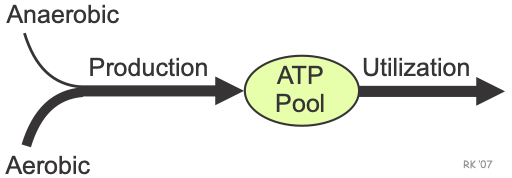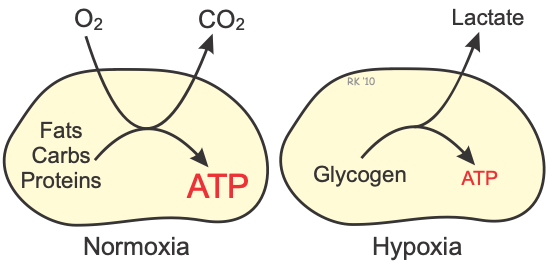Myocardial Metabolism
Cellular processes require ATP as a primary energy source. The heart requires ATP for the function of membrane transport systems (e.g., Na+/K+-ATPase) as well as for sarcomere contraction and relaxation, which involves myosin ATPase and ATP-dependent transport of calcium by the sarcoplasmic reticulum. Therefore, increasing the mechanical activity of the heart by increasing heart rate and contractility increases myocardial oxidative metabolism (click here for more information).

Cellular ATP pools depend on the balance between ATP utilization and ATP production. The heart has an absolute requirement for aerobic production of ATP to maintain adequate ATP concentrations because anaerobic capacity is limited in the heart. Cellular ATP levels rapidly fall if there is insufficient O2 available to produce ATP aerobically, or if there is an increase in ATP utilization (increased ATP hydrolysis) that is not matched by a parallel increase in ATP synthesis.
 The heart can use various substrates to regenerate ATP oxidatively, depending upon availability. In the postabsorptive state several hours after a meal, the heart uses fatty acids (60-70%) and carbohydrates (~30%). Following a high carbohydrate meal, the heart can adapt itself to use carbohydrates (primarily glucose) almost exclusively. Lactate can be used in place of glucose, and becomes a crucial substrate during exercise. The heart can also metabolize amino acids and ketones instead of fatty acids. Ketone bodies (e.g., acetoacetate) are important in diabetic acidosis. During ischemia and hypoxia, the coronary circulation cannot deliver sufficient metabolic substrates to the heart to support aerobic metabolism. Under these conditions, the heart can use glycogen (a storage form of carbohydrate) as a substrate for the anaerobic production of ATP and the formation of lactic acid. However, the amount of ATP that the heart can produce by this pathway is small compared to the amount of ATP that can be produced by aerobic metabolism. Furthermore, the heart has a limited supply of glycogen, which is rapidly depleted under severely hypoxic conditions.
The heart can use various substrates to regenerate ATP oxidatively, depending upon availability. In the postabsorptive state several hours after a meal, the heart uses fatty acids (60-70%) and carbohydrates (~30%). Following a high carbohydrate meal, the heart can adapt itself to use carbohydrates (primarily glucose) almost exclusively. Lactate can be used in place of glucose, and becomes a crucial substrate during exercise. The heart can also metabolize amino acids and ketones instead of fatty acids. Ketone bodies (e.g., acetoacetate) are important in diabetic acidosis. During ischemia and hypoxia, the coronary circulation cannot deliver sufficient metabolic substrates to the heart to support aerobic metabolism. Under these conditions, the heart can use glycogen (a storage form of carbohydrate) as a substrate for the anaerobic production of ATP and the formation of lactic acid. However, the amount of ATP that the heart can produce by this pathway is small compared to the amount of ATP that can be produced by aerobic metabolism. Furthermore, the heart has a limited supply of glycogen, which is rapidly depleted under severely hypoxic conditions.
Revised 01/30/2023

 Cardiovascular Physiology Concepts, 3rd edition textbook, Published by Wolters Kluwer (2021)
Cardiovascular Physiology Concepts, 3rd edition textbook, Published by Wolters Kluwer (2021) Normal and Abnormal Blood Pressure, published by Richard E. Klabunde (2013)
Normal and Abnormal Blood Pressure, published by Richard E. Klabunde (2013)